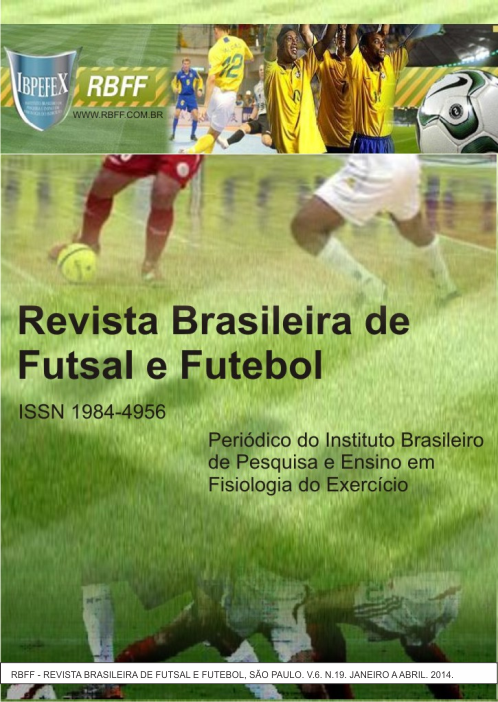Analysis of the factors determining the goal in women’s futsal
Abstract
Introduction: Futsal has been expanding worldwide. In the game the central objective is thegoal, because its amount determines the outcome of the match. Therefore, it is important to study the determinants of goal and meet influential variables in its obtaining, as the place and time that it occurs, the move sources, the technical performance or how other variables can contribute to the planning of the training of the teams. Objective: To evaluate the incidence of goals and associated factors in women's futsal Championship matches of Rio Grande do Sul State in 2011. Materials and methods: It wasanalyzed 12 matches of Universidade Católica de Pelotas (UCPel) in the State Championship, women's Futsal in 2011. Through video and the score sheetit were analyzed variables associated with the marking of goals, among them, the time of occurrence (firstor second), the influence of the row goalkeeper, technical performance of the team at the time of the goal and the court sector that led to the goal. Results: Over the games there were 28 goals scored in favor and 63 against the UCPel. The largest number occurred in the final 10 minutes of the matches and originated in the opposite area. The influence of the row goalkeeper was small and only in the final moments. Technical performance aspects such as disarmament and missed passes have correlation with goals scored and conceded. Conclusion: It is suggested to emphasize the training in techniques and tactics similar to those actions that happen in the final minutes and reorganize defensive systems used to protect your area, because it is within it that occur more goals
References
-Amaral, R.; Garganta, J. A modelação do jogo em Futsal. Análise sequencial do 1x1 no processo ofensivo. Revista Portuguesa de Ciências do Desporto. Vol. 3. p. 298-310. 2005.
-Bezerra, R. B.; Navarro, A. C. Análise dos gols da VI Taça Brasil de Clubes 2010 na categoria sub-20 feminino. Revista Brasileira de Futsal e Futebol. Vol. 4. Núm. 11. p. 47-54. 2012. Disponível em: <http://www.rbff.com.br/index.php/rbff/article/view/124/122>
-Dias, R. M. R.; Santana, W. C. Tempo de incidência dos gols em equipes de diferentes níveis competitivos na copa do mundo de futsal. EFDeportes.com Revista Digital. Núm. 101. 2006.
-Flores, V.; Rech, R. Incidência de gols sofridos de forma geral e por escalões temporais em equipes finalistas e demais participantes na categoria sub 15 nas competições organizadas pela liga caxiense de futsal nos anos de 2008 e 2009. Revista Brasileira de Futsal e Futebol. Vol. 4. Núm. 11. p. 17-22. 2012. Disponível em: <http://www.rbff.com.br/index.php/rbff/article/view/121/118>
-Fukuda, J. P. S.; Santana, W. C. Análises dos gols em jogos da Liga de Futsal 2011. Revista Brasileira de Futsal e Futebol. Vol. 4. Núm. 11. p. 62-66. 2012. Disponível em: <http://www.rbff.com.br/index.php/rbff/article/view/125/124>
-Ganef, E.; Reis, F. P. C.; Almeida, E. S.; Navarro, A. C. Influência do goleiro-linha no resultado do jogo de futsal. Revista Brasileira de Futsal e Futebol. Vol. 1. Núm. 3. p. 186-192. 2009. Disponível em: <http://www.rbff.com.br/index.php/rbff/article/view/24/24>
-Gomes, S. A.; Sotero, R. C.; Giavoni, A.; Melo, G. F. Avaliação da composição corporal e dos níveis de aptidão física de atletas de futsal classificados segundo a tipologia dos esquemas de gênero. Revista Brasileira de Medicina do Esporte. Vol. 17. Núm. 3. p. 156-160. 2011.
-Irokawa, G. N. F. Lima, M. R. M.; Soares, V. O. V.; Aburachid, L. M. C.; Souza, P. R. C.; Greco, P. J. Caracterização das circunstâncias e setores de finalização do jogo de futsal: um estudo da fase final da copa do mundo de futsal-FIFA 2008. EFDeportes.com Revista Digital. Núm. 144. 2010.
-Massardi, F. P.; Oliveira, M. C.; Navarro, A. C. A incidência de gols na liga futsal feminina nos anos 2010 e 2011. Revista Brasileira de Futsal e Futebol. Vol. 3. Núm. 9. p. 232-238. 2011. Disponível em: <http://www.rbff.com.br/index.php/rbff/article/view/102/96>
-Nakayama, J. P. Caracterização da distância, localização e tempo de jogo dos gols no futsal feminino de alto rendimento. Revista Brasileira de Futsal e Futebol. Vol. 3. Núm. 9. p. 197-205. 2011.
-Navarro, A. C.; Costa, J. S. O momento do gol na copa do mundo de futsal de 2004. Revista Brasileira de Futsal e Futebol. Vol. 1. Núm. 2. p. 129-133. 2009. Disponível em: <http://www.rbff.com.br/index.php/rbff/article/view/16/16 >
-Santos, R. S. Análise dos gols em contra-ataque na Copa da UEFA de futsal 2010. Revista Brasileira de Futsal e Futebol. Vol. 2. Núm. 6. p. 171-178.2010. Disponível em: <http://www.rbff.com.br/index.php/rbff/article/view/64/60 >
-Silva, D. F.; Oliveira, M. L.; Silva, C. D. Características do futsal masculino amador em uma cidade do interior de Minas Gerais. EFDeportes.com Revista Digital. Núm. 145. 2010.
-Tritschler, K. Medida e avaliação em Educação Física e Esporte de Barrow e McGee. 5. ed. Barueri: Manole, 2000.
-Valentini, C. E. Chincoviaki, F.; Liberali, R; Almeida, R. Comparação do desempenho técnico dos jogadores de futsal pelo scout nas categorias sub-9, sub-11 e sub-13 das escolinhas da cidade de Aurora. Revista Brasileira de Futsal e Futebol. Vol. 2. Núm. 4. p. 25-28. 2010. Disponível em: <http://www.rbff.com.br/index.php/rbff/article/view/37/37 >
Authors who publish in this journal agree to the following terms:
- Authors retain the copyright and grant the journal the right of first publication, with work simultaneously licensed under the Creative Commons Attribution License BY-NC which allows the sharing of the work with acknowledgment of the authorship of the work and initial publication in this journal.
- Authors are authorized to enter into additional contracts separately for non-exclusive distribution of the version of the work published in this journal (eg, publishing in institutional repository or book chapter), with acknowledgment of authorship and initial publication in this journal.
- Authors are allowed and encouraged to post and distribute their work online (eg, in institutional repositories or on their personal page) at any point before or during the editorial process, as this can bring about productive change as well as increase impact and impact. citation of published work (See The Effect of Free Access).





